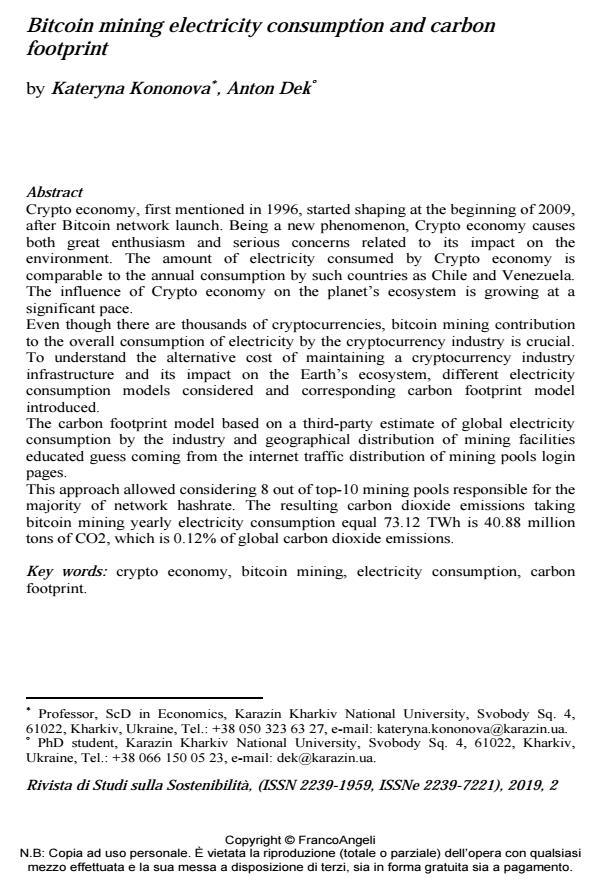Bitcoin mining electricity consumption and carbon footprint
Titolo Rivista RIVISTA DI STUDI SULLA SOSTENIBILITA'
Autori/Curatori Kateryna Kononova, Anton Dek
Anno di pubblicazione 2020 Fascicolo 2019/2
Lingua Inglese Numero pagine 16 P. 73-88 Dimensione file 527 KB
DOI 10.3280/RISS2019-002007
Il DOI è il codice a barre della proprietà intellettuale: per saperne di più
clicca qui
Qui sotto puoi vedere in anteprima la prima pagina di questo articolo.
Se questo articolo ti interessa, lo puoi acquistare (e scaricare in formato pdf) seguendo le facili indicazioni per acquistare il download credit. Acquista Download Credits per scaricare questo Articolo in formato PDF

FrancoAngeli è membro della Publishers International Linking Association, Inc (PILA)associazione indipendente e non profit per facilitare (attraverso i servizi tecnologici implementati da CrossRef.org) l’accesso degli studiosi ai contenuti digitali nelle pubblicazioni professionali e scientifiche
Crypto economy, first mentioned in 1996, started shaping at the beginning of 2009, after Bitcoin network launch. Being a new phenomenon, Crypto economy causes both great enthusiasm and serious concerns related to its impact on the environment. The amount of electricity consumed by Crypto economy is comparable to the annual consumption by such countries as Chile and Venezuela. The influence of Crypto economy on the planet’s ecosystem is growing at a significant pace. Even though there are thousands of cryptocurrencies, bitcoin mining contribution to the overall consumption of electricity by the cryptocurrency industry is crucial. To understand the alternative cost of maintaining a cryptocurrency industry infrastructure and its impact on the Earth’s ecosystem, different electricity consumption models considered and corresponding carbon footprint model introduced. The carbon footprint model based on a third-party estimate of global electricity consumption by the industry and geographical distribution of mining facilities educated guess coming from the internet traffic distribution of mining pools login pages. This approach allowed considering 8 out of top-10 mining pools responsible for the majority of network hashrate. The resulting carbon dioxide emissions taking bitcoin mining yearly electricity consumption equal 73.12 TWh is 40.88 million tons of CO2, which is 0.12% of global carbon dioxide emissions.
Parole chiave:Crypto economy, bitcoin mining, electricity consumption, carbon footprint.
Kateryna Kononova, Anton Dek, Bitcoin mining electricity consumption and carbon footprint in "RIVISTA DI STUDI SULLA SOSTENIBILITA'" 2/2019, pp 73-88, DOI: 10.3280/RISS2019-002007